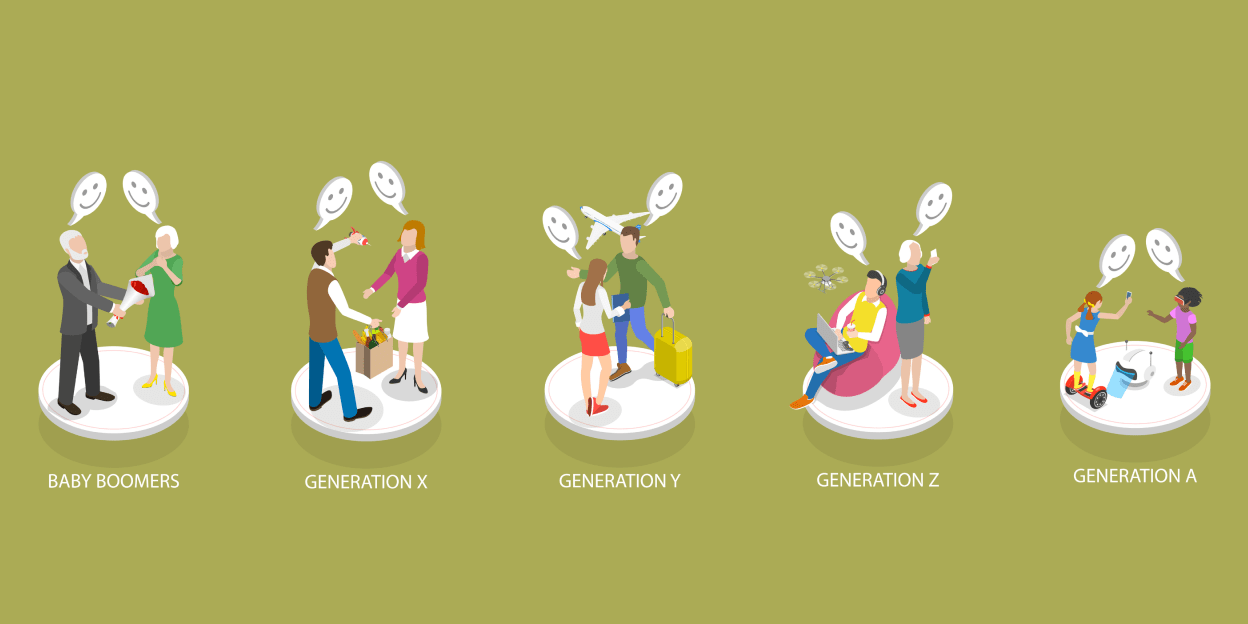The best approach to direct your product or service to a multi-generational audience can vary depending on your customers' ages.
As with any form of marketing, generational marketing requires a strategic approach and an in-depth understanding of the factors that interest your target market. While one approach works well for a specific demographic, this does not necessarily mean that it will appeal to all age groups in the same way. This is why it's crucial to research successful strategies for convincing those of all ages to engage with your business.
But how exactly can you utilise marketing to increase customer acquisition across all generations in 2024? To explore the topic in further detail, Feefo has created this guide to break down the aspects that make each generation click on businesses in the digital age.
What is Generational Marketing?
As the name suggests, "generational marketing" refers to segmenting and targeting an audience based on their generation.
While different generations may have some similarities, each typically possesses its own ideals, beliefs, and passions. This can make it slightly tricky for businesses to appeal to each generation unless they know how to successfully market themselves in a way that will attract members of each generation.
Over the last few decades, significant technological developments have shaped how many consumers interact with businesses online. Younger generations have grown up in the digital age and are accustomed to shopping online with new and emerging businesses. Meanwhile, older generations have needed more time to adapt to the influx of the internet and eCommerce and may, therefore, be inclined to stick with products and brands they already know and trust. This means a varied approach is required to market yourself to both generations.
Generational Breakdown
We first need to look at the various existing generations to learn how to increase customer acquisition. Currently, there are six main generational groups.
Silent Generation (1926-1945)
This is the oldest generation to market yourself towards. Members of the Silent Generation are typically looking for products that make their lives easier and may feel more inclined to remain loyal to brands they are familiar with. This generation is unlikely to respond to online marketing strategies as they are unaccustomed to newer technology.
Baby Boomers (1946-1964)
Baby Boomers are the generation that grew up in the post-war era. As a result, they have seen a large amount of economic growth and have typically spent a long period in the workforce. This gives them immense purchasing power and usually means they have more disposable income.
The Baby Boomer generation has spent the majority of their life without modern technology, but unlike the Silent Generation, they have rapidly become accustomed to the presence of social media and online shopping.
Generation X (1965-1980)
In contrast to the preceding generation, Generation X grew up during a recession and is also the smallest. Members of this generation are a lot more reluctant to switch to new products, preferring to stick to what they know. This can challenge new businesses trying to appeal to those in this age bracket.
Millennials (1981-1996)
Millennials were the first to grow up with modern technology, meaning they are far more likely to respond to online marketing campaigns. They are also the largest generation, providing a broad pool of potential customers for businesses that can capture their interest. They are among the first generations to respond well to influencer marketing and social media campaigns.
Generation Z (1997-2010)
Generation Z, known as 'Gen Z', is generally the most tech-savvy generation. They grew up with similar technology to our current-day smartphones, the internet, and social media. While many in this generation are still relatively young, their spending power should not be underestimated. This generation likes to get the most out of their money, relying heavily on user reviews before purchasing and engaging heavily with businesses through social media.
Generation Alpha (2011-2024)
Finally, the newest generation is Generation Alpha. Many in this generation are still children, meaning they have limited access to money. Instead, Generation Alpha exert their purchasing power by convincing their parents to buy the products they are interested in.
As a generation that has only known our current era of technology, Gen Alpha are very receptive to social media and influencer marketing. Many within this age group spend much of their time using social media platforms, including TikTok.
Adapting Your Customer Acquisition Strategy
Now that we understand how these generations differ, how can your business implement a customer acquisition strategy that attracts people of all ages?
Feefo's CMO, Kerry Leighton-Bailey, shares her advice:
It is vital for businesses to acknowledge that one single marketing approach may not work across all generations. Instead, multiple channels may be required to bring the maximum number of consumers to your brand. While social media campaigns tend to do well with younger generations, they would be very unlikely to encourage members of the Silent Generation, and even the older consumers in the Baby Boomers generation to purchase your products or use your services."
Research shows that, overall, consumers typically respond better to marketing messages tailored to them specifically. While preparing an entirely individual advertisement every time isn't feasible, businesses can still generate the same effect by simply taking the time to consider the social, economic, and political backgrounds of their target demographics — segmenting them in a way that allows them to create generationally-individual marketing messages.
Now, we will analyse the available marketing channels and assess which generations are most likely to align themselves with each.
Social Media
Social media is one of the newest methods of marketing your business to customers that also offers the most possibilities for marketing campaigns. There are over 5 billion social media users globally — creating a comprehensive customer pool to appeal to. Users are typically comprised of Generation Alpha, Gen Z, and Millennials, though you may also find some Baby Boomers present.
Successful marketing strategies include targeted advertising, interactive posts (such as polls), and influencer partnerships. While the former two typically work with Millennials, the power of influencer marketing for Gen Z and Gen Alpha should not be underestimated. Customers want to buy products that real people endorse, which validates a product or service.
As with any marketing, ensuring your content is tailored to your chosen audience is essential. For example, Generation Alpha are primarily children, so word-heavy social media posts are unlikely to appeal to them like an engaging video format would. Similarly, Gen Z is the Meme Generation, so they tend to be more engaged with businesses that know how to respond to trends.
Printed Media
Print media refers to several marketing materials, including magazine and newspaper advertisements, printed fliers, posters, and postcards. This form of marketing can be more expensive than simply posting on social media. However, if your business aims to persuade Silent Generation members to buy from you, this is undoubtedly the method of choice.
While magazine sales have decreased by almost 40% in recent years, mainly due to the influx of social media, some still opt to buy physical publications. These are typically those in older age brackets who respond well to a classic advertisement. Similarly, while posting fliers or postcards is unlikely to win your business new customers from younger generations, it can prove highly effective with those who are older and, therefore, not regularly online.
Email Marketing
Similar to printed media, email marketing often feels overlooked in this social media era. However, this channel's strength lies in reaching broad audiences. Most people, regardless of age, will have an email address. Naturally, businesses should ensure that their marketing messages are accessible to all age groups, opting for a neutral approach that isn't too word-heavy.
Broadcast Advertising
Broadcast advertising is one of the oldest forms of getting your brand's image out to the public, and it is also one of the easiest ways to target individual generations. This channel refers to radio and television advertising, which offers a range of possibilities to target specific audiences. Some market research will quickly help you identify which age groups tend to watch or listen to each broadcast medium, ensuring you can easily target different generations.
Unfortunately, broadcast marketing is also an expensive route to take. On average, a 30-second TV advertisement can cost upwards of £2,000. Therefore, it's essential to take the time to curate an advert that will accurately portray your business or products to your target audience.
Generational Marketing with Feefo
Customer reviews are among the most effective ways to reach people of all ages. According to our 2019 Consumer Trends Report, 96% of UK consumers use reviews in some way, and 64% read them before making a purchase.
However, there can often be some scepticism over the validity of customer reviews.
With Feefo, you can collect verified reviews for your business, providing peace of mind for potential customers. Thanks to our verification process, you can be sure that each of our user reviews is 100% genuine. And, with our data capture service, we'll gather information about your customers that makes targeting your business to others like them even more straightforward.
So, if you're ready to start your generational marketing journey, contact our customer service team today and learn more about how we can help.



